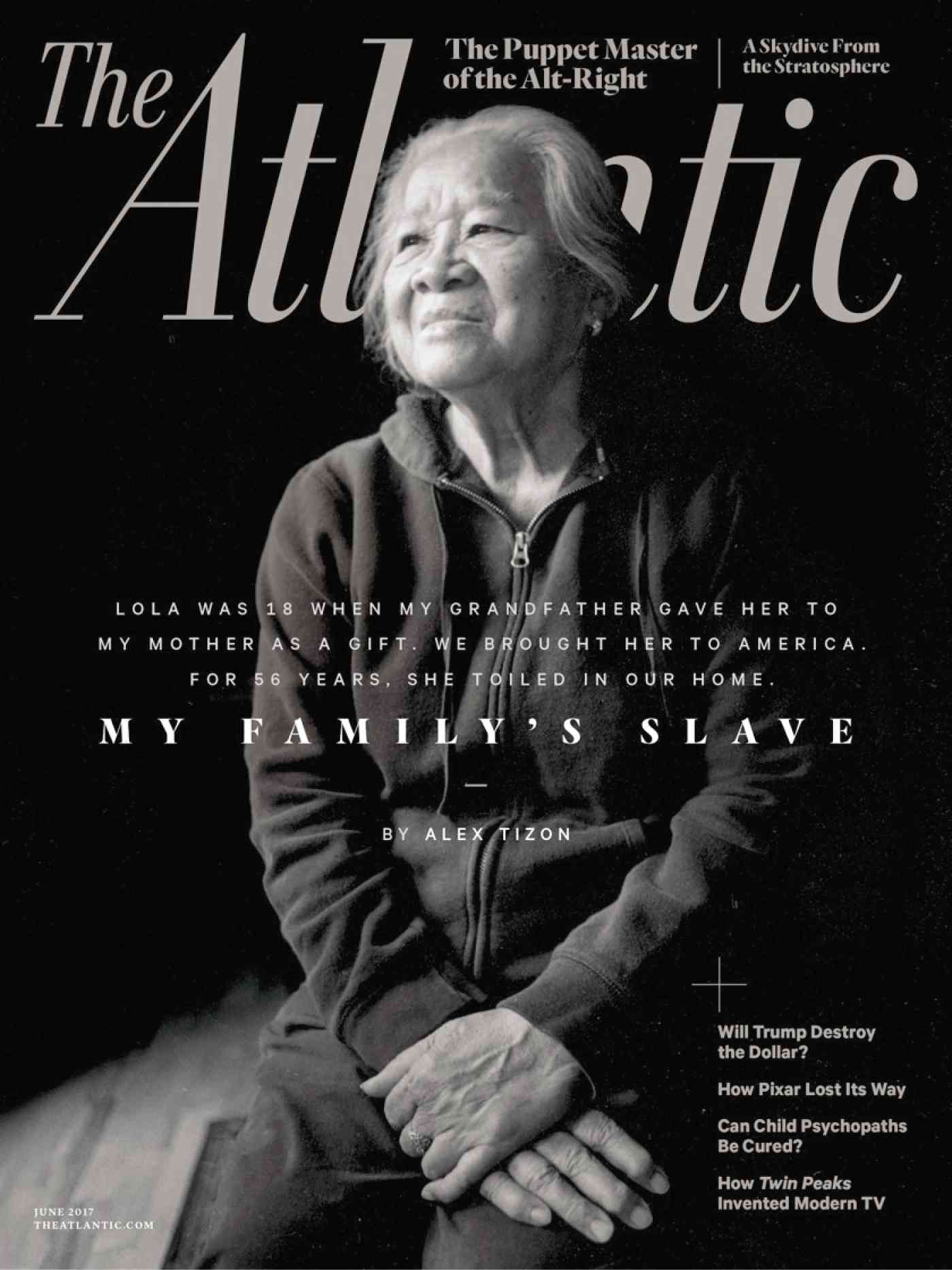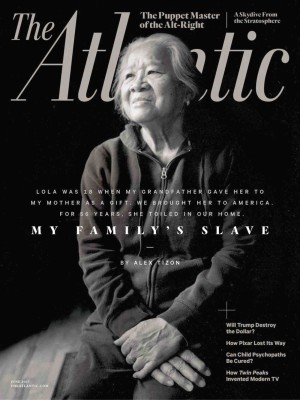It is extremely rare that a very long article goes viral on the internet, but Alex Tizon’s “My Family’s Slave” has done just that in the past week.
Although known and recognized in the United States as an author, professor and journalist (he shared the Pulitzer Prize in 1997 while on the staff of the Seattle Times), Tizon was an unrecognized voice in his own mother country.
The irony is that his cover story in the very prestigious The Atlantic for its June issue ran after Tizon had passed away from natural causes at age 57 on March 23. In an uncanny coincidence, the decision to make this story the magazine’s main one came on the day he died.
Tizon’s story is highly unusual in that having migrated to the United States via the Philippine Foreign Service (his father was a commercial analyst in the Los Angeles Consulate and in the Seattle Consulate from 1964-1969, and resigned after his stint there), the family retained a domestic helper who was, by Western and international standards, “a slave.”
They managed to keep this a secret from friends, associates and American immigration authorities. Any misstep could have led to their prosecution or eventual deportation. According to Tizon, Eudocia Tomas Pulido, or Lola, as she was addressed in the family, was given when she was 18 years old to his mother as a “gift” by her own father, Lieutenant Tomas Asuncion, who had “lots of land but little money and kept mistresses in separate houses on his property.” This landowner from Camiling, Tarlac, had apparent dark secrets of his own; later in life, he put a bullet through his head with a 32-caliber gun.
Feudal background
The family’s feudal background is reflected in the story told by Tizon’s mother, with some glee, about how Lola took 12 whiplashes in her stead from her father for some infraction.
In America, Lola “prepared three meals a day, cleaned the house, waited on (the) parents, and took care of (Tizon’s) four siblings and (him).” His parents never paid her and scolded her constantly. At times, she was subjected to physical violence. “She wasn’t kept in leg irons, but she might as well have been.”
The parents bluntly refused to give her help and accused Lola of being selfish when her own parents fell ill and died in the Philippines. She was not allowed to return home. She never received dental care, such that her teeth resembled “a crumbling Stonehenge.” “So many nights,” Tizon recounts, “I’d spot her sleeping in a corner, slumped against a mound of laundry, her fingers clutching a garment she was in the middle of folding.”
This might not have raised as many eyebrows in the Philippines in the ’60s and ’70s, but this took place in the heartland of America. Some Filipinos may argue against the use of the word “slave,” with all its implications from the American Civil War, as against the more inclusive Filipino concept of a “kasambahay” (or kasama sa bahay, a house companion) who has become a virtual family member.
What makes this case extreme is that not only did it take place in the United States, but that Lola never received any compensation, something unthinkable even in Manila nowadays. What makes it even more bizarre for some who do not understand the cultural matrix is how Lola never made any moves to break free.
Tizon’s father was a lawyer and his mother, a doctor, who pursued the American dream at the expense of Lola, who was a factor in the stability of their family and household. Oftentimes, she was the only adult in the house, especially after Tizon’s father abandoned the family after 25 years of marriage.
Exploited
Tizon’s mother, who sometimes had to take 24-hour shifts, became a successful if lowly paid internist in the small town of Salem, Oregon. When her Filipino husband abandoned her, she married Ivan, a Croatian immigrant who exploited her for money.
Tizon and his brother Arthur realized, as they grew into their teens, the abnormality of Lola’s situation, and came to articulate her situation as that of “a slave.” This became a bone of contention between the siblings and their mother, who became jealous of their closeness to Lola. Tizon himself left his family home at age 23 due to conflicts with his mother.
Lola was the household confidante and loyal retainer who, despite deeply resenting Tizon’s mother, defended her from her second husband and sat by her bedside as she lay dying of cancer in 1999. When the priest asked the mother if there was anything she wanted to be forgiven for, she said nothing and put her hand on Lola’s head.
When Lola turned 75, Tizon inherited her from his mother, and to his credit, he and his wife tried to make up for his family’s abuse. He gave her a $200 weekly salary and the assurance that she was truly free to do as she pleased. Lola proved unable to break her habit of servitude, however.
Tizon also sponsored a trip home for Lola on her 83rd birthday to visit her family, after which she nonetheless decided to stay with Tizon’s family in the United States.
Her family was Alex Tizon’s siblings, his mother and his own children, whom she came to regard as her own. Hence, while indeed there was exploitation, Lola herself might not have regarded it as such.
Lola passed away at age 86, and in a masterful recounting of a trip back through lahar country, Tizon tells of how he accompanied her ashes back to her hometown. By this time, only her 98-year-old sister Gregoria, her niece Ebia and their extended family were there.
A question may be asked, why this somewhat Gothic tale has fascinated both American and Filipino audiences.
For Americans, it reveals an underworld that exists in pockets throughout America which, while it no longer officially condones slavery, nevertheless tolerates sweatshops as well as underpaid or exploited illegal immigrants, and welcomes cheap goods manufactured in Third World countries (even by Trump enterprises).
Unexplored tradition
For Filipinos, the still unexplored history and tradition of slavery in our country raises uneasy questions, like, why does 10 percent of our population work and live abroad? Why do we pride ourselves in being nannies or “caregivers” to the world? Why do we maintain a servile foreign policy in the process of changing our masters, protectors or so-called allies?
The late Alex Tizon himself viewed his family’s relationship with Lola from an American perspective. For instance, he asserts that the Spanish came “in the 15th (sic) century” to enslave the Filipinos and brought African and Indian slaves, as well, presumably through Latin America. In fact, the Law of the Indies expressly forbade slavery, and there is no evidence that slaves were ever brought from America or Africa to populate the Philippines.
To be sure, Spanish friar rule was paternalistic and servitude continued, but Christianity introduced a new world view in which both datu and alipin would be judged by the same God, and rewarded or punished in the same measure. In fact, it was Muslims from the South who continued the practice of slave raids in the Visayas and parts of Luzon.
One might argue that even the Tizons became slaves to the American dream, as distilled through the prism of neocolonialism in the Philippines. Since the father earned only $5,600 a year as a commercial analyst in a Philippine consulate, he took on odd jobs to supplement his income. The mother worked 24-hour shifts to become a doctor. In the end, both achieved their goal of settling their brood successfully in the United States, but at the expense of a broken family—and Lola.
America represented success, and it would never have occurred to them to move back to the Philippines, which would have meant abject failure.
This is a tale repeated in various forms in our overseas Filipino workers. Instead of using labor in our own country, we send our women to places like Saudi Arabia, Singapore and Hong Kong, even when we know that they will be subjected to subhuman conditions and paid slave wages. After the President’s visits to China and Russia, government agencies trumpeted that those countries would welcome Filipino OFWs as “caregivers.”
Alipin or oripun may sound like antiquated terms to us, but in light of a more overtly revived datu tradition today, this morality tale of Alex Tizon and his family could explain the mentality behind our continuing and burgeoning national bondage.















































